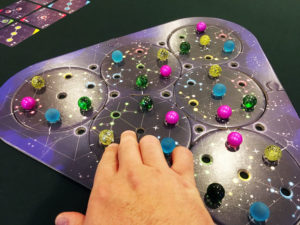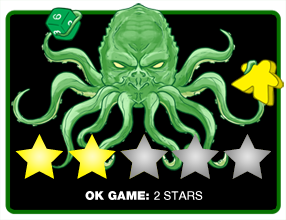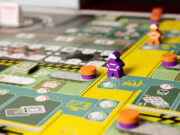 Commonly here at Board Game Quest, reviews are doled out to the writer with the most street cred for a given theme or mechanism. Here in the Astronomical Creation and Modification Game Review Office, there’s a sense of pride in taking any game about the manipulation of the galaxy seriously. When, Stellium, a game about moving stars and planets into alignment came across my desk, interest was piqued.
Commonly here at Board Game Quest, reviews are doled out to the writer with the most street cred for a given theme or mechanism. Here in the Astronomical Creation and Modification Game Review Office, there’s a sense of pride in taking any game about the manipulation of the galaxy seriously. When, Stellium, a game about moving stars and planets into alignment came across my desk, interest was piqued.
Players in Stellium are some type of godlike beings with the power to alter cosmological objects at the beginning of the universe. A game board made of disks that rotate on the play surface function as galaxies swirling in the outer reaches of space. When a player causes astronomical bodies (marbles) to form an alignment that matches with an objective, they collect points. All in all, it’s an abstract game for 2-4 players that the box says takes 30 minutes to play. Depending on how much analysis paralysis is induced by the game, playtime could be much higher. For that and other reasons, it’s best with 2 players.
Gameplay Overview:
The game board is comprised of six rotating disks held together with a cardboard boundary. Marbles drawn from a bag represent the astronomical objects placed on one of seven spaces on each disc. Objective cards are also set up beside the board that shows the configurations of colors of marbles required for scoring points.

On a player’s turn, they will reach into a black bag filled with the marble supply. By feeling the textures of the marbles in the bag (there are four different ones), a player has five seconds to select a marble to place. Once in hand, each color marble follows a different placement rule unless the player uses one of their four influence tokens. If a player’s adjustment of the board state results in a marble alignment that meets one of the objective cards, they may take the card for points (Stelliums).
Besides having skills at identifying textures to get marbles, Stellium also requires a good eye for spatial manipulation. The four different types of placement rules are as follows:
Green (Planet) – When placed, it switches the position of two other marbles.
Blue (Comet) – When this marble is placed on an occupied space, any marbles already there are pushed in a direction along with other marbles in the line.
Yellow (Star) – After placement, the entire galaxy disk can be rotated any amount.
Pink (Supernova) – After placement, any black hole space (the spaces between galaxies) can pull in a marble from an adjacent galaxy.
Following these rules, once a player collects a certain number of Stelliums (30 points in a two-player game), the play round finishes. Then the player with the highest number of points wins.

Game Experience:
Let’s get something out-of-the-way up front, this reviewer is not a huge fan of abstract games. Stellium, as an abstract game, has enough theme to attract interest, but there are also some design choices which are extremely distracting from the overall experience.
First, the ability to grab a certain texture of marble in a certain amount of time feels really out-of-place for an abstract game. Only one of the marbles (yellow/star) has such an obvious texture that it can be grabbed quickly. The others are varying shades of smoothness and it can be quite difficult to make a guess in picking one in a time crunch.

Since a player’s ability to create alignments of certain colors depends highly on what type of marble was used, the first issue affects the second. Hence, the ability to progress the game is limited. As players are placing and moving marbles, they really need moments to place a very specific color of marble. If they aren’t lucky in the draw and they are haptically challenged, the game will crawl with minor moves nowhere closer to scoring points.
And unfortunately, the final and most significant complaint is also affected by the previous two. Each player’s turn can disrupt the play area considerably. If one player is trying to achieve a certain objective, they can set back by multiple moves by other players before their next move comes around. The game objectives for this type of game do not seem to match with the playstyle. When played with four players, beware of the more random ability to score.
Final Thoughts:
Specifically for this reviewer, Stellium is not fun. Getting past the first complaint wouldn’t be that big of a challenge if it weren’t for the second and third. It’s a well-executed but ill-conceived design that results in a high degree of analysis paralysis and turn-to-turn inadvertent disruptive play. There’s little entertaining here, but Stellium doesn’t feel broken. Players who enjoy a huge curveball and don’t mind some difficulty with spatial operations may find more.
Final Score: 2 Stars – Unique design choices create a different but also frustrating experience that hampers fun with every turn.
 Hits:
Hits:
• Unique mechanisms
• Nice box insert
Misses:
• Rules translation issues
• Frustrating design goals
• Induces AP in players























